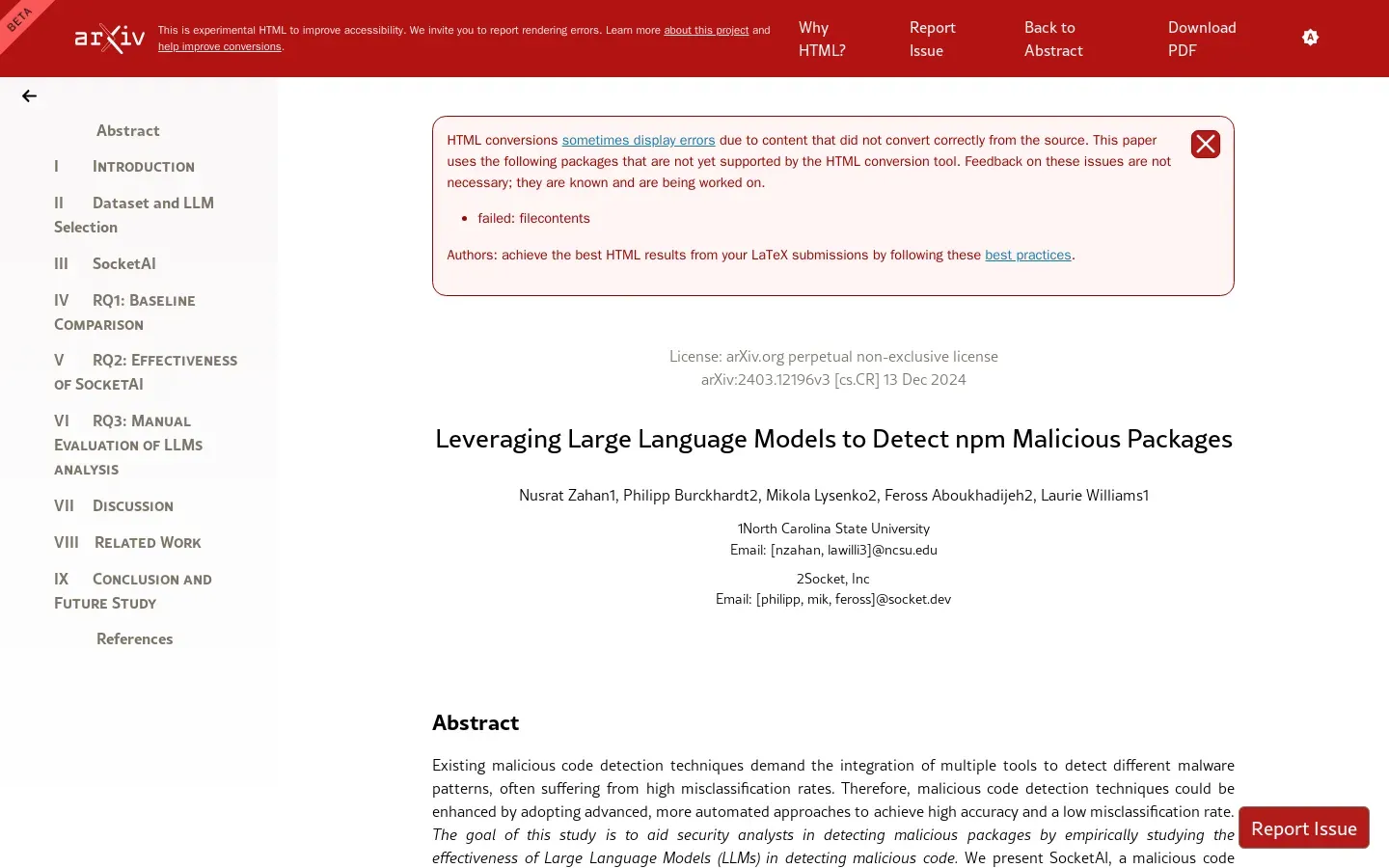
Large Language Models Enhance Detection of Malicious npm Packages
/ 4 min read
Quick take - Recent research has examined the use of advanced machine learning models, particularly Large Language Models, to improve malicious code detection in cybersecurity, highlighting both their effectiveness and the challenges that remain in fully understanding and mitigating threats.
Fast Facts
- Integration of LLMs: Research focuses on using Large Language Models to enhance cybersecurity, particularly in malicious code detection, aiming to improve accuracy and reduce false positives/negatives.
- Methodology: The study involved dataset construction, comparison with static analysis tools, implementation of the SocketAI workflow, and qualitative analysis of malicious activities.
- Key Findings: LLMs demonstrated improved detection rates but faced limitations in fully understanding coding environments, which can obscure malicious intent.
- Strengths and Limitations: The research highlighted enhanced detection capabilities and iterative self-refinement but noted challenges in detecting malicious code across diverse programming environments.
- Future Applications: Suggested future directions include integrating detection models into CI/CD pipelines, cross-language detection, and enhancing developer education on malicious code risks.
Enhancing Cybersecurity: The Role of Machine Learning in Malicious Code Detection
In a rapidly evolving digital landscape, cybersecurity remains a top priority for organizations worldwide. Recent research has delved into the integration of advanced machine learning models, particularly Large Language Models (LLMs), to bolster cybersecurity measures. This study addresses the pressing need for improved malicious code detection, focusing on the efficacy of these innovative methodologies within software ecosystems.
The Core Objectives
The primary aim of this research is to explore how LLMs can enhance cybersecurity by improving the accuracy of malicious code detection while reducing false positives and negatives. By examining various analytical approaches, the study seeks to understand how these models can be effectively integrated into existing development practices.
Methodology: A Multifaceted Approach
The research employed a comprehensive methodology that included several key components:
-
Dataset Construction and Selection: Carefully curated datasets were utilized to train and test the models, ensuring a broad coverage of potential threats.
-
Baseline Comparison with Static Analysis Tools: The performance of LLMs was compared against traditional static analysis methods to establish a baseline for effectiveness.
-
SocketAI Workflow Implementation: A specific workflow named SocketAI was implemented to optimize the detection process.
-
Qualitative Analysis of Malicious Activities: This involved an in-depth examination of how malicious activities manifest across different coding environments.
Key Findings
The study revealed significant strengths in utilizing LLMs for malicious code detection. These models demonstrated an enhanced capacity to improve traditional methods, showcasing their potential in diverse ecosystems. However, limitations were also identified, particularly concerning the models’ ability to fully comprehend their operational environment, which could obscure malicious intent.
Strengths Highlighted
- Improved Detection Rates: The integration of LLMs resulted in better detection rates across various ecosystems.
- Iterative Self-Refinement Workflow: This approach facilitated continuous model improvement through real-time feedback.
Limitations and Challenges
Despite promising results, certain limitations were noted:
- Complexity in Varied Environments: Accurately detecting malicious code across different programming environments remains challenging.
- Mode Collapse and Hallucination: Further research is needed to address these issues in LLM outputs.
Recommended Tools and Techniques
Several tools and techniques were discussed as beneficial for enhancing cybersecurity efforts:
- SocketAI: A workflow designed to streamline malicious code detection processes.
- CodeQL: A powerful tool for querying code to identify vulnerabilities.
- Iterative Self-Refinement: A technique for enhancing model accuracy through feedback loops.
- Zero-Shot Role-Play Chain of Thought (CoT) Prompting: A novel approach guiding models in understanding complex scenarios without extensive retraining.
Future Directions and Applications
The implications of this research suggest several promising future applications:
- Integration with CI/CD Pipelines: Embedding these detection models into Continuous Integration/Continuous Deployment processes for real-time threat identification.
- Cross-Language Detection Capabilities: Developing capabilities to detect threats across different programming languages.
- Enhanced User Education and Awareness: Promoting understanding among developers regarding the risks of malicious code and the importance of utilizing advanced detection methods.
This research underscores the transformative potential of LLMs in cybersecurity, highlighting both their strengths and areas requiring further investigation. As organizations continue to face sophisticated cyber threats, integrating such advanced technologies could prove pivotal in safeguarding digital infrastructures.



